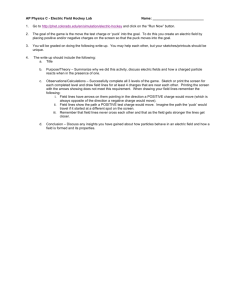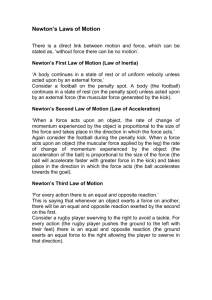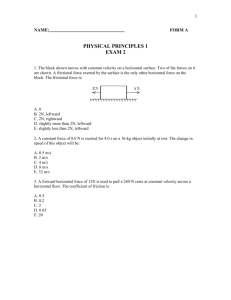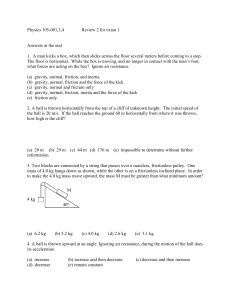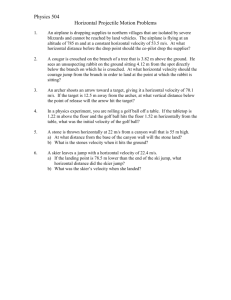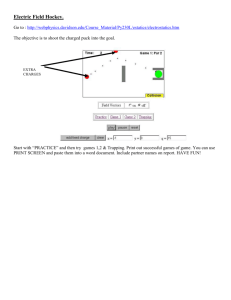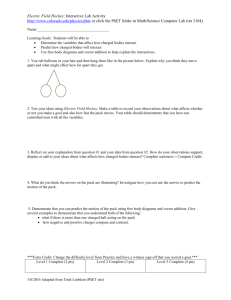General Physics Semester #1 Review Sheet (2012
advertisement
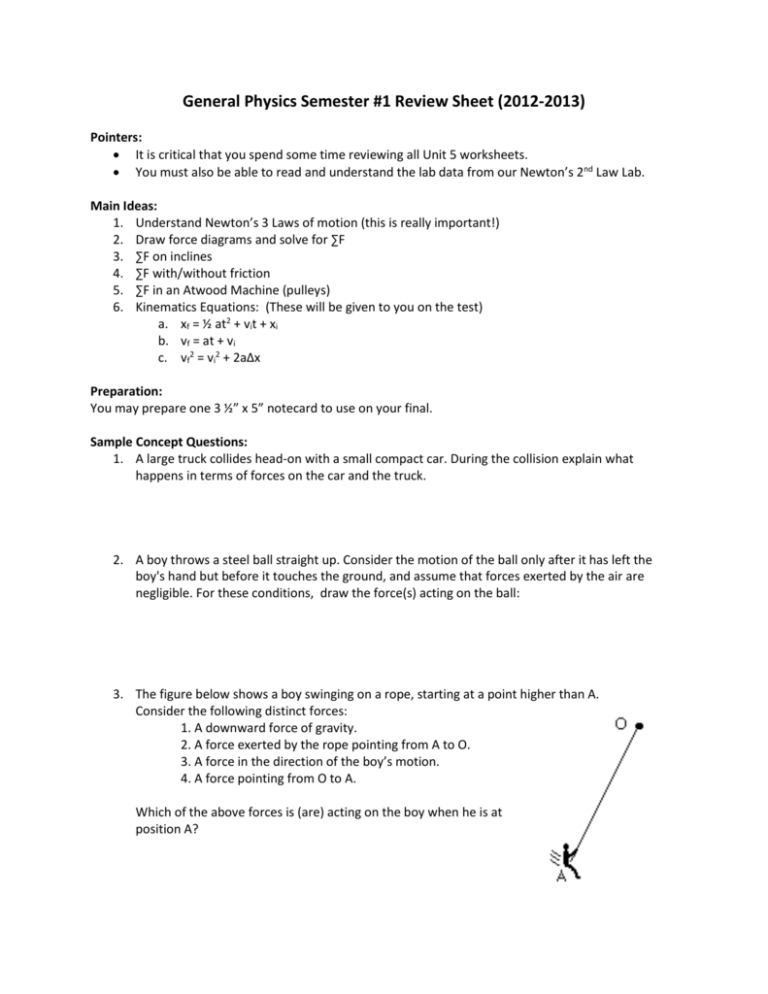
General Physics Semester #1 Review Sheet (2012-2013) Pointers: It is critical that you spend some time reviewing all Unit 5 worksheets. You must also be able to read and understand the lab data from our Newton’s 2nd Law Lab. Main Ideas: 1. Understand Newton’s 3 Laws of motion (this is really important!) 2. Draw force diagrams and solve for ∑F 3. ∑F on inclines 4. ∑F with/without friction 5. ∑F in an Atwood Machine (pulleys) 6. Kinematics Equations: (These will be given to you on the test) a. xf = ½ at2 + vit + xi b. vf = at + vi c. vf2 = vi2 + 2aΔx Preparation: You may prepare one 3 ½” x 5” notecard to use on your final. Sample Concept Questions: 1. A large truck collides head-on with a small compact car. During the collision explain what happens in terms of forces on the car and the truck. 2. A boy throws a steel ball straight up. Consider the motion of the ball only after it has left the boy's hand but before it touches the ground, and assume that forces exerted by the air are negligible. For these conditions, draw the force(s) acting on the ball: 3. The figure below shows a boy swinging on a rope, starting at a point higher than A. Consider the following distinct forces: 1. A downward force of gravity. 2. A force exerted by the rope pointing from A to O. 3. A force in the direction of the boy’s motion. 4. A force pointing from O to A. Which of the above forces is (are) acting on the boy when he is at position A? USE THE STATEMENT AND FIGURE BELOW TO ANSWER THE NEXT FOUR QUESTIONS (4 through 7). The diagram depicts a hockey puck sliding, with a constant velocity, “vo”, from point “a” to point “b” along a frictionless horizontal surface. When the puck reaches point “b”, it receives an instantaneous horizontal kick, “vk” in the direction of the heavy arrow. 4. Draw the path the hockey puck will move after receiving the kick? 5. How does the speed of the puck just after it receives the kick compare with the speed of the puck before it was kicked? 6. Along the frictionless path you have chosen in question 4, explain what the speed of the puck will be. Why? 7. Along the frictionless path you have chosen in question 4, draw a force diagram of the force(s) acting on the puck after receiving the kick. USE THE STATEMENT AND FIGURE BELOW TO ANSWER THE NEXT TWO QUESTIONS (8 and 9). A large truck breaks down out on the road and receives a push back into town by a small compact car as shown in the figure below. 8. Draw a force diagram for both vehicles while the car, still pushing the truck, is speeding up to get up to cruising speed. Use a DASHED LINE to connect those forces that are related by Newton’s Third Law. 9. Draw a force diagram for both vehicles after the car reaches the constant cruising speed at which its driver wishes to push the truck: Use a DASHED LINE to connect those forces that are related by Newton’s Third Law. 10. An elevator is being lifted up an elevator shaft at a constant speed by a steel cable as shown in the figure below. All frictional effects are negligible. Draw a force diagram for the elevator: 11. In the figure at right, student "a" has a mass of 95 kg and student "b" has a mass of 77 kg. They sit in identical office chairs facing each other. Student "a" places his bare feet on the knees of student "b", as shown. Student "a" then suddenly pushes outward with his feet, causing both chairs to move. During the push and while the students are still touching one another, draw a force diagram for both students. Use a DASHED LINE to connect those forces that are related by Newton’s Third Law. 12. An empty office chair is at rest on a floor. Consider the following forces: 1. A downward force of gravity. 2. An upward force exerted by the floor. 3. A net downward force exerted by the air. Which of the forces is (are) acting on the office chair? Explain why. 13. A woman exerts a constant horizontal force on a large box. As a result, the box moves across a horizontal floor at a constant speed “vo”. Draw a force diagram of the forces acting on the box. 14. If the woman in the previous question doubles the constant horizontal force that she exerts the box to push it on the same horizontal floor, explain how the box then moves. 15. If the woman in question 13 suddenly stops applying a horizontal force to the box, explain how the box’s motion changes. Explain why. Sample Problems: 1. An 80 kg water skier is being pulled by a boat with a force of 220 N causing the skier to accelerate at 1.8 m/s2. Find the drag force on the skier. 2. A 2000 kg car is slowed down uniformly from 20 m/s to 5 m/s in 4 seconds. Determine the average net force on the car during this time, and how far the car traveled while slowing down. 3. Some baseball pitchers are capable of throwing a fast ball at 100 mi/hr. The pitcher achieves this speed by moving his arm through a distance of 1.5 m. Determine the average net force that must be exerted on the 0.15 kg ball during the pitch. (1 mile = 1600 meters) 4. The cord is 25˚ above the horizontal. The mass of kids and sled = 100 kg. The tension in cord is 120 N and the friction force is 15 N. Find the acceleration of the sled. 5. The hill is at a 35˚ angle and the skier’s mass is 60 kg. The friction force is 40 N. Determine the acceleration of the skier.

